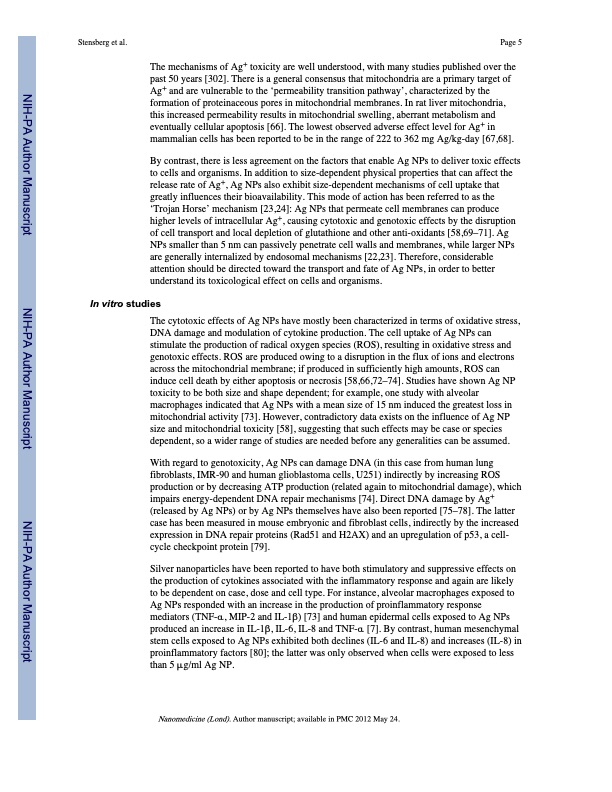
PDF Publication Title:
Text from PDF Page: 005
Stensberg et al. Page 5 The mechanisms of Ag+ toxicity are well understood, with many studies published over the past 50 years [302]. There is a general consensus that mitochondria are a primary target of Ag+ and are vulnerable to the ‘permeability transition pathway’, characterized by the formation of proteinaceous pores in mitochondrial membranes. In rat liver mitochondria, this increased permeability results in mitochondrial swelling, aberrant metabolism and eventually cellular apoptosis [66]. The lowest observed adverse effect level for Ag+ in mammalian cells has been reported to be in the range of 222 to 362 mg Ag/kg-day [67,68]. By contrast, there is less agreement on the factors that enable Ag NPs to deliver toxic effects to cells and organisms. In addition to size-dependent physical properties that can affect the release rate of Ag+, Ag NPs also exhibit size-dependent mechanisms of cell uptake that greatly influences their bioavailability. This mode of action has been referred to as the ‘Trojan Horse’ mechanism [23,24]: Ag NPs that permeate cell membranes can produce higher levels of intracellular Ag+, causing cytotoxic and genotoxic effects by the disruption of cell transport and local depletion of glutathione and other anti-oxidants [58,69–71]. Ag NPs smaller than 5 nm can passively penetrate cell walls and membranes, while larger NPs are generally internalized by endosomal mechanisms [22,23]. Therefore, considerable attention should be directed toward the transport and fate of Ag NPs, in order to better understand its toxicological effect on cells and organisms. In vitro studies The cytotoxic effects of Ag NPs have mostly been characterized in terms of oxidative stress, DNA damage and modulation of cytokine production. The cell uptake of Ag NPs can stimulate the production of radical oxygen species (ROS), resulting in oxidative stress and genotoxic effects. ROS are produced owing to a disruption in the flux of ions and electrons across the mitochondrial membrane; if produced in sufficiently high amounts, ROS can induce cell death by either apoptosis or necrosis [58,66,72–74]. Studies have shown Ag NP toxicity to be both size and shape dependent; for example, one study with alveolar macrophages indicated that Ag NPs with a mean size of 15 nm induced the greatest loss in mitochondrial activity [73]. However, contradictory data exists on the influence of Ag NP size and mitochondrial toxicity [58], suggesting that such effects may be case or species dependent, so a wider range of studies are needed before any generalities can be assumed. With regard to genotoxicity, Ag NPs can damage DNA (in this case from human lung fibroblasts, IMR-90 and human glioblastoma cells, U251) indirectly by increasing ROS production or by decreasing ATP production (related again to mitochondrial damage), which impairs energy-dependent DNA repair mechanisms [74]. Direct DNA damage by Ag+ (released by Ag NPs) or by Ag NPs themselves have also been reported [75–78]. The latter case has been measured in mouse embryonic and fibroblast cells, indirectly by the increased expression in DNA repair proteins (Rad51 and H2AX) and an upregulation of p53, a cell- cycle checkpoint protein [79]. Silver nanoparticles have been reported to have both stimulatory and suppressive effects on the production of cytokines associated with the inflammatory response and again are likely to be dependent on case, dose and cell type. For instance, alveolar macrophages exposed to Ag NPs responded with an increase in the production of proinflammatory response mediators (TNF-α, MIP-2 and IL-1β) [73] and human epidermal cells exposed to Ag NPs produced an increase in IL-1β, IL-6, IL-8 and TNF-α [7]. By contrast, human mesenchymal stem cells exposed to Ag NPs exhibited both declines (IL-6 and IL-8) and increases (IL-8) in proinflammatory factors [80]; the latter was only observed when cells were exposed to less than 5 μg/ml Ag NP. Nanomedicine (Lond). Author manuscript; available in PMC 2012 May 24. NIH-PA Author Manuscript NIH-PA Author Manuscript NIH-PA Author ManuscriptPDF Image | Toxicological studies on silver nanoparticles

PDF Search Title:
Toxicological studies on silver nanoparticlesOriginal File Name Searched:
nihms-316964.pdfDIY PDF Search: Google It | Yahoo | Bing
Turbine and System Plans CAD CAM: Special for this month, any plans are $10,000 for complete Cad/Cam blueprints. License is for one build. Try before you buy a production license. More Info
Waste Heat Power Technology: Organic Rankine Cycle uses waste heat to make electricity, shaft horsepower and cooling. More Info
All Turbine and System Products: Infinity Turbine ORD systems, turbine generator sets, build plans and more to use your waste heat from 30C to 100C. More Info
CO2 Phase Change Demonstrator: CO2 goes supercritical at 30 C. This is a experimental platform which you can use to demonstrate phase change with low heat. Includes integration area for small CO2 turbine, static generator, and more. This can also be used for a GTL Gas to Liquids experimental platform. More Info
Introducing the Infinity Turbine Products Infinity Turbine develops and builds systems for making power from waste heat. It also is working on innovative strategies for storing, making, and deploying energy. More Info
Need Strategy? Use our Consulting and analyst services Infinity Turbine LLC is pleased to announce its consulting and analyst services. We have worked in the renewable energy industry as a researcher, developing sales and markets, along with may inventions and innovations. More Info
Made in USA with Global Energy Millennial Web Engine These pages were made with the Global Energy Web PDF Engine using Filemaker (Claris) software.
Infinity Turbine Developing Spinning Disc Reactor SDR or Spinning Disc Reactors reduce processing time for liquid production of Silver Nanoparticles.
| CONTACT TEL: 608-238-6001 Email: greg@infinityturbine.com | RSS | AMP |